The Submission
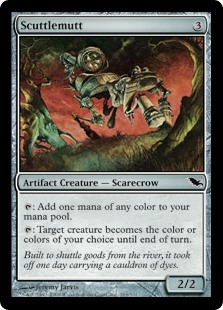
Cube archetypes are reliant upon two different types of cards, the flashy spotlight cards, such as Exhume or Reanimate in a reanimation archetype, and the supporting cast, which act to drive multiple archetypes forward, such as the large creatures which represent reanimation targets. These large creatures are not added expressly to support reanimation, and they can also act as ramp targets, finishers in control decks, curve-toppers in mid-range decks, etc. These multi-purpose support cards come in many forms, but a particular support card that simply begs to be featured in multiples, and indeed to have the rest of the cube shaped around it, is Scuttlemutt.
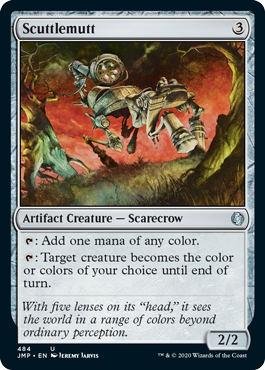
Now that you are back after reading Scuttlemutt‘s text and trying to figure out exactly what it does, and why you would ever want it in a cube, let’s lay out the basics:
- It is a colourless creature which taps for any colour of mana.
- It taps to change the colour of creatures.
Now, the use of the first should be pretty obvious. Ramp is great, and mana fixing is great, especially with no colour requirements, but it is the second ability that is the truly interesting part of the card. Changing the colours of a creature is normally pretty worthless in a regular cube, with the exception of the occasional creature with Fear or Intimidate that needs blocking. That said, many effects and abilities throughout Magic’s history reference the colours of a card, and adding the ability to change a creature’s colours with decent regularity allows for the construction of a cube based around a simple concept, ‘Colour-Matters’.
Whilst Scuttlemutt could be as simple as a vulnerable mana-rock which occasionally transforms an otherwise sideboard card such as Celestial Purge into maindeck removal, this article is going to go the way of Shadowmoor, and make colour a central component to the cube. It is here that multiple Scuttlemutts allows cards which otherwise wouldn’t have a chance of making a cube to become true powerhouses.
As mentioned, Scuttlemutt’s colour changing allows Celestial Purge to become a much stronger card, as well as boosting Deathmark and Combust from the same cycle. Now, with the addition of the Theros ‘self-hate’ cycle, there is now a wide selection of removal which is colour dependent. Celestial Purge, Combust and Deathmark are joined by Glare of Heresy and Dark Betrayal, which when combined with colour changing options, such as Scuttlemutt, and a greater inclusion of hybrid cards (discussed below), have the potential to become premium removal options.
In order for this type of beneficial colour-changing to be anything more than an occasional fortuitous occurrence, supplementary colour changing options are required. Focusing on the playable (and believe me, there are unplayable ones…) options, we have Cloudchaser Kestrel, the more frequently seen Eight-and-a-Half-Tails, Govern the Guildless and Blind Seer (Who I assume works of the principle of “I can’t see which colour this is. I am going to assume it is red.”). Multiple copies of some of these cards, in combination with Scuttlemutt, allows for colour-changing to become a more consistent drafting strategy.
There are a large number of cards which care about the colour of a creature for more than just killing them, such as the cycle of ‘colour-lords’ from the Shadowmoor block, such as Wilt-Leaf Liege and Glen Elendra Liege. These are all very powerful cards, although they usually miss the call up to cube (often because of the Hybrid/Gold card classification issue, which is only an issue if you let it be one). When these cards can become flexible in the creatures that they buff, they become much more palatable than simply relying on the 1-2 other green/white creatures in the cube. Scuttlemutt gives this flexibility, but these cards do still rely upon a critical mass of multi-coloured a hybrid permanents to be worthwhile. (Aside: Civic Saber)
Of course, adding an increased number of cards which rely upon certain and indeed multiple colours to a cube requires a expanded multi-colour section, which in turn requires good mana-fixing, so the land section must be adjusted to accommodate. Slower lands such as the Alara tri-lands and lands such as Rupture Spire suddenly begin to look more acceptable, and suddenly the initially obvious colour-fixing utility of Scuttlemutt becomes important again.
After having gone through all of the excitement of trying to break colour changing effects, it feels a little mundane to discuss a creature type. Nevertheless, Scuttlemutt has a creature type. It is Scarecrow. If only there was some sort of card that cared about Scarecrows…

Reaper King. Reaper King cares about scarecrows (Apparently to throw at other permanents, but who are we to judge?). In addition, it is a multi-colour creature for all of the above shenanigans. Reaper King acts as the anchor card for something of a scarecrow mini-archetype, and the whole cycle of Skulkins are scarecrows who act to support the colour-matters archetypes established previously (It is almost as if the Shadowmoor block designers meant it this way…).
While there are a number of ways you can take this initial sketch of a cube shaped by Scuttlemutt (For instance, how Shadowmoor’s wither plays really nicely with Proliferate and other counter-manipulation, which in turn plays beautifully with Sunburst, which just loops us back to the multi-color concept… Or how anyone paying attention to Standard lately knows just how good hybrid mana symbols are for devotion…), at that point I am taking the focus away from Scuttlemutt and instead designing an entire cube, which was not the point of this article. Scuttlemutt is a unique card that is functional in a vacuum as nothing more than a ramp and fixing effect, yet the effects of colour-changing transform it into a card which has the potential to be a powerful player in many archetypes, if you can just design the perfect cube for it.
Addendum
One of the primary reasons why I chose to focus upon Scuttlemutt is that it is one of very few cards that affect colour, yet is playable even if you only treat that as an unlikely bonus. Color changing is an effect which was much more popular early in Magic’s history, and the power disparity of cards from that era is nearly unforgivable from a game design standpoint. You have to be going really really deep to play something like Lifelace in any conceivable environment.
When brainstorming for this idea, I saw the colour changing affects to be something of a U/W concept in this Cube (With blue having a ‘meddling’ feel, with colour-changing and counter-manipulation). Scuttlemutt is however designed as a somewhat universal support card, buoyed in part by the fact that it is colourless. It fixes colour for the enlarged multi-colour section, as well as improving Sunburst (which was the cross-over point between the counter-manipulation theme (Which focused on charge counters on artifacts) and the multi-colour themes).
The above article chose to focus upon the colour-related sections, as they more directly relate to the role of Scuttlemutt in that Cube. Supporting the colour-changing archetype are Cloudchaser Kestrel (probably two copies) and Eight-and-a-Half-Tails in White, and Govern the Guildless (Again, probably two copies) and Blind Seer (Who I cannot help but imagine works on the principle of ‘They all look the same colour to me.’).
At some point I was digging pretty deep, and was considering Painter’s Servant, Glamerdye, and Swirl the Mists to increase the range of colour-targeting spells (and including cards such as Gainsay and Flashfreeze). It must be said, Painter’s Servant and indeed Swirl the Mists can become pretty broken pretty quickly with Llawan, Cephalid Empress in the Cube.
I will update the initial post to further expand the supporting colour-change cards. As for how many Scuttlemutts? Well, it feels strange to ever say more than 4 of a card, but assuming we are building this cube to resemble a booster draft environment, that number could be higher. It seems like sacrilege to say so though, so 4.
Jason’s Critique
This idea is pretty imaginative, and I think there’s potential in building an off-beat cube where some of these themes can thrive. Color matters is a theme that hasn’t been explored much in Magic’s history, and part of my worry is that the changes listed here haven’t quite gone deep enough. Scuttlemutt is at its most interesting when it can affect the board in interesting ways. Maybe you’re turning off your opponents enchantments or messing with various protection effects on their side or your side of the board.
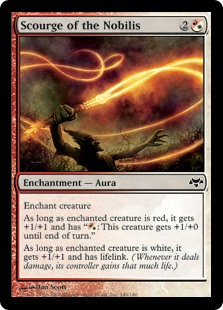

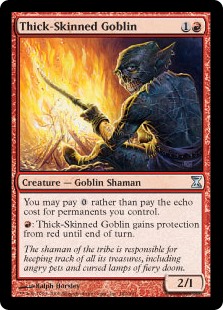
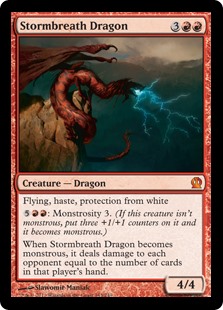
Although it is true that something like Celestial Purge becomes more viable, how many color changing effects do you need in your deck before such a card becomes maindeckable? Are we going to have a greater gold and hybrid density in the set to make these cards less narrow? Unless the removal options are incredibly sparse, I can’t imagine turning to Dark Betrayal without a high density of color changing effects in my deck. If I have a high density of these cards, chances are others don’t. Is there competing demand for a card like Dark Betrayal?
And how many players at the table will really want these cards in their decks? My worry is that we begin to jam our environment with narrow cards that are only of interest if heavily committed to a given deck.
All said, I think there are some great ideas, including the astute find Civic Saber and the various color lords. I would direct my attention away from the super narrow effects and more towards finding a web of cards and mechanics that Scuttlemutt can interact with that aren’t useless in the absence of a color-changing effect. There’s some real potential here, and with some work you could build a fleshed out environment along the lines of something like the Eldrazi Domain cube.
Eric’s Critique
I have to admit, I didn’t know what a Scuttlemutt was. I had to read the card. Then I had to read it again. Huh. Innnnnnteresting. I’m immediately reminded of the time that people tried to get Liquimetal Coating to work in Standard, by pairing it with a heap of Tuktuk Scrappers. Suddenly all your Shatters were Vindicates, and your Scrappers were Flametongues.
My first thoughts are that this isn’t a card you can just jam multiples of into any ol’ cube, but rather, Scuttlemutt would be optimal in a cube that is built around the color matters theme, as Jason mentioned. I have to admit I’m a little skeptical as to how deep this theme could go, though, and am more than a little worried that the best color hosers haven’t been historically distributed evenly across the colors (assuming we’re ignoring the mass color hosers that were a staple of early Magic). Celestial Purge and Eight-and-a-Half-Tails give white a lot of space to play around with in this theme, but what about poor green? Stuff like Autumn’s Veil is hard to salvage, even with creative uses of Scuttlemutt. Even the good color hosers have the same problem that commonly used protection creatures, like Mirran Crusader, have in cube: they can be all-stars in some matches, and duds in others, and it’s randomly determined by which colors your opponent happened to draft. That Crusader or Deathmark might completely dominate in one matchup, and then be decidedly mediocre (or useless!) in other, without any interesting or meaningful decisions on either your or your opponent’s parts. Not everybody is always going to have a Scuttlemutt handy, and the situations where people don’t should still provide for good interaction.
Like Jason, I think there’s an interesting concept here, but without seeing this idea fully developed, I worry that there isn’t enough meat here to sustain hungry cube drafters. And while I love the idea of Scuttlemutt being an all-star in some cube out there, it requires too much warping of a non-themed cube for most people to commit to.
Return to contest entries.

